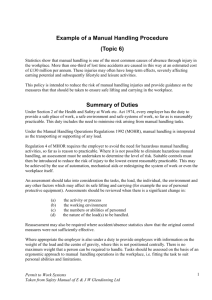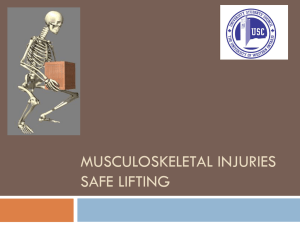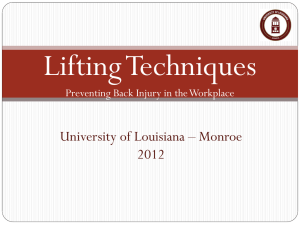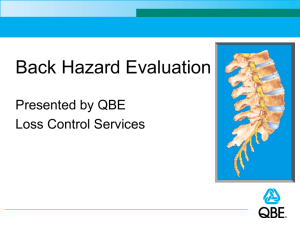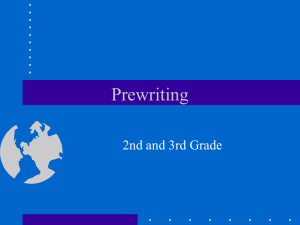General Manual Handling Risk Assessment
advertisement
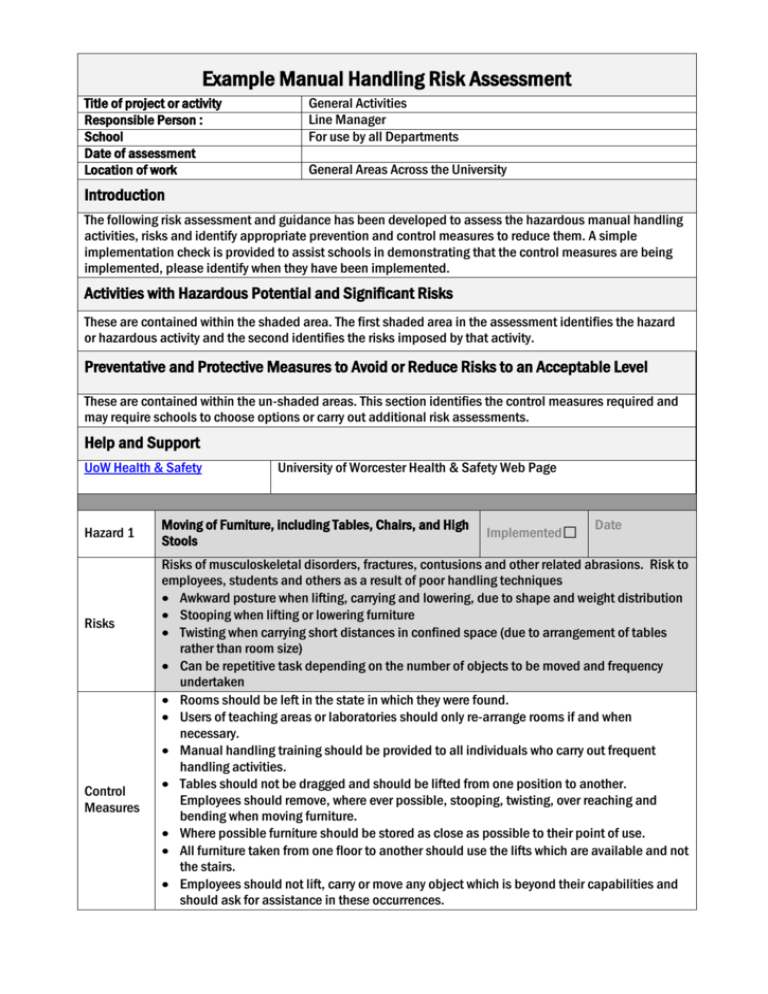
Example Manual Handling Risk Assessment Title of project or activity Responsible Person : School Date of assessment Location of work General Activities Line Manager For use by all Departments General Areas Across the University Introduction The following risk assessment and guidance has been developed to assess the hazardous manual handling activities, risks and identify appropriate prevention and control measures to reduce them. A simple implementation check is provided to assist schools in demonstrating that the control measures are being implemented, please identify when they have been implemented. Activities with Hazardous Potential and Significant Risks These are contained within the shaded area. The first shaded area in the assessment identifies the hazard or hazardous activity and the second identifies the risks imposed by that activity. Preventative and Protective Measures to Avoid or Reduce Risks to an Acceptable Level These are contained within the un-shaded areas. This section identifies the control measures required and may require schools to choose options or carry out additional risk assessments. Help and Support UoW Health & Safety Hazard 1 Risks Control Measures University of Worcester Health & Safety Web Page Moving of Furniture, including Tables, Chairs, and High Stools Implemented Date Risks of musculoskeletal disorders, fractures, contusions and other related abrasions. Risk to employees, students and others as a result of poor handling techniques Awkward posture when lifting, carrying and lowering, due to shape and weight distribution Stooping when lifting or lowering furniture Twisting when carrying short distances in confined space (due to arrangement of tables rather than room size) Can be repetitive task depending on the number of objects to be moved and frequency undertaken Rooms should be left in the state in which they were found. Users of teaching areas or laboratories should only re-arrange rooms if and when necessary. Manual handling training should be provided to all individuals who carry out frequent handling activities. Tables should not be dragged and should be lifted from one position to another. Employees should remove, where ever possible, stooping, twisting, over reaching and bending when moving furniture. Where possible furniture should be stored as close as possible to their point of use. All furniture taken from one floor to another should use the lifts which are available and not the stairs. Employees should not lift, carry or move any object which is beyond their capabilities and should ask for assistance in these occurrences. Porter services are available for manual handling tasks and should be used when significant handling activities are to be carried out. Tables Some tables are likely to be too difficult and awkward for single person to relocate. Team lifting should be carried out for heavy or unwieldy tables. High Stools High stools are unwieldy and should be moved one by one. Chairs Stack height of chairs should be solid and secure. They must not exceed shoulder height. Restrict the numbers of chairs carried by individuals. Depending on the weight of the chairs and individual capabilities of the employees, chairs should be restricted to 2 - 4 at any time. If numbers of chairs need to be moved frequently and on the same day a specialized adapted chairs trolley should be obtained and used or the porter’s services should be contacted. Hazard 2 Risks Control Measures Hazard 3 Risks Control Measures Mail and Postbags Implemented Date Risks of musculoskeletal disorders, fractures, contusions and other related abrasions. Risk to employees, students and others as a result of poor handling techniques. Carrying mail and/or post bags repetitively and over distances Unwieldy and unstable when stacked. Stacked materials potentially at risk from falling. Where possible have deliveries of mail dropped off at the point of use. Use appropriate postbags and carrying devices. Use a trolley with a raised wheel base or dropped down sides even for small amounts of post Use lifts when transporting between floors Use good base lifting techniques Boxes and Deliveries Implemented Date Risks of musculoskeletal disorders, fractures, contusions and other related abrasions. Risk to employees, students and others as a result of poor handling techniques. Stooping and or jerky movements when lifting or putting down boxes Awkward posture when carrying boxes Having to re-distribute parcels/boxes after main delivery Contents too heavy to lift/ move easily or for packaging Unwieldy or uneven weight distribution depending on what the box contains Where possible have deliveries of mail dropped off at the point of use. Where boxes and deliveries are heavy contact should be made with the supplier to reduce the weight to an acceptable limit, e.g. 10-15Kg. Employees should be trained in manual handling techniques and use these when lifting boxes or other deliveries. Employees must test the weight of boxes prior to moving them. Reading delivery slip will provide a good indication of what is in the box, weights of the load and its weight distribution. Good base techniques should be employed and employees should consider the distances to be travelled. Trolleys should be used where possible. Where distances travelled are in excess of 10m and a trolley is not available, employees should consider resting. Where this is used items should be rested on levels above floor height and as near to waist level as possible. Cardboard boxes should be in good condition and employees should inspect them prior to lifting or moving. Where boxes are found to be in poor conditions or defect the employee should not move the box. Employees should consider removing the contents and placing them into a suitable alternative. Hazard 4 Risks Control Measures Hazard 5 Risks Control Measures Moving and/or Setting Out of Equipment Implemented Date Risks of musculoskeletal disorders, fractures, contusions and other related abrasions. Risk to employees, students and others as a result of poor handling techniques. Carrying long distances to point of use and storage. Restricted space on retrieval or placement causing twisting to occur. Stored inappropriately i.e. above shoulder height or below knee height on floor. Stooping when lifting and lowering equipment. Awkward, heavy equipment which can difficult to grasp securely. Repetitive movements in setting out equipment. Porter services are available for manual handling tasks and should be used when significant handling activities are to be carried out. Employees required to move equipment should be trained in manual handling techniques and should use these when ever moving, setting out or storing equipment. Use lifts when transporting equipment between floors. Where possible, equipment should be stored as near to point of use as possible and at appropriate height according to weight of equipment and frequency of its use. Good base techniques should be employed when moving equipment. Employees should consider the distances to be travelled. Appropriate trolleys should be used where possible i.e. platform/sack barrows, 2/3 tier trolleys and cages etc. Where distances travelled are in excess of 10m and a trolley is not available, employees should consider resting. Where this is used items should be rested on levels above floor height and as near to waist level as possible. Breaks or change in activity should be deployed if setting out a significant quantity of equipment regardless of individual weight. Transporting of Files and Papers Implemented Date Risks of musculoskeletal disorders, contusions and other related abrasions. Risk to employees, students and others as a result of poor handling techniques. Individual weight of objects disguises the combined weight – deceptively heavy. Files/papers are unstable when stacked. Stacked materials potentially at risk from falling. Use a trolley with a raised wheel base or drop down sides even for the smaller quantities of files and papers Use lifts when transporting between floors Hazard 6 Risks Handling and Lifting from a Sitting Position Implemented Date Risks of musculoskeletal disorders. Risk to employees, students and others as a result of poor handling techniques. Poor posture, leading to back ache and restricted blood flow to legs. Repetitive actions and strain injury Bending, stooping and twisting. Control Measures Hazard 7 Risks Control Measures Hazard 8 Risks Control Measures Desk and chair set at incorrect height for task at hand. Every employee should be shown correct sitting posture and desk arrangement DSE assessment should be carried out for those who sit in front of DSE regularly and this should ensure good housekeeping Reduce the amounts and repetitive actions of lifting and handling as far as possible. Store items which require movement below shoulder height, above knee height and in appropriate locations for access. The guideline figures are 3Kg for females and 5Kg for males, however, this will depend on the individual’s capabilities and health. Manual Handling by those who are Pregnant or who have Health Conditions Date Risk of aggravating a pre existing health concern / condition. Risk to employees, students and others. Specific risk assessments must be developed for those employees who are pregnant, are new mothers or have a health issues which could be affected by carrying out manual handling activities. Individuals with health problems, e.g. back problems or other muscular disorder, should be referred to, assessed and monitored by Occupational Health. Referrals should be made prior to employees carrying out handling activities. Where the manual handling activity involves the supporting, lifting / lowering, pushing / pulling awkward, bulky or heavy objects employees who are pregnant or have health conditions my need to be excused from the activities. Manual Handling and the Storage of Materials Implemented Date Risks of musculoskeletal disorders, fractures, contusions and other related abrasions. Risk to employees, students and others as a result of poor handling techniques Awkward posture when lifting, carrying and lowering, due to shape and weight distribution Stooping when lifting or lowering furniture Twisting when carrying short distances in confined space Sufficient secure shelving should be provided to minimise the need for items to be stored below knee height or on the floor. Alternatively minimise the quantities of items stored on the floor sufficiently to ensure that the floor is kept free from clutter and potential tripping hazards. Where items are stored at a position which requires access equipment, only suitable and appropriate stepladders should be used. These should be class 1 or class 2 ladders and not those designated for domestic use. Clear unobstructed walkways and access must be maintained at all times, to enable the unhindered use of trolleys to point of delivery/collection in storage cupboards, and to enable good manual handling techniques to be exercised to avoid the need for overstretching, overreaching or bending over obstructions to obtain an item. Small obstructions should be moved to one side when access is required to enable the object/item to be easily retrieved. Emergency Procedures Risks Control Measures Implemented Implemented Date Inadequate supply of first aiders or first aid supplies. Risk to employees, students and others. First aid cover is available and in place at all times The workplace is in close proximity to the NHS Services. Hazards Risks Control Measures Assessor Name Additional Control Measures Required (List and Implement) Implemented Responsible Person / Manager Name Signature Date Signature Date Date N/A
